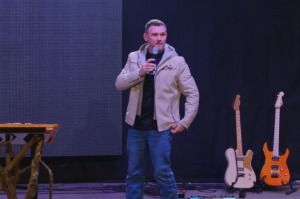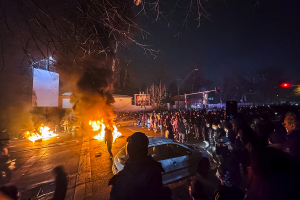Casey Anthony Update: Video Shown of Investigators Searching Wooded Area Caylee Was Later Found
After Casey Anthony was found competent to continue with trial Monday morning, the court resumed, continuing to call witnesses including Dr. Kenneth Furton who testified that human decomposition could not be detected by any scientific instrument.
His testimony was objected to by the state on Saturday but was allowed to testify in court today.
Furton spoke to refute the prosecution’s testimony from Dr. Arpad Vass from Oak Ridge Labs who claimed that human decomposition could be detected from the trunk of Casey’s car. Vass stated that there were five major chemicals consistent with human decomposition found in the air samples collected from the trunk of the Pontiac.
However, Furton asserted there was no scientifically valid instrument that could currently identify chemicals consistent to human decomposition, though there were tools able to detect volatile organic compounds.
Furton also spoke of the incomplete findings from Oak Ridge. He emphasized that no quantitative analysis was performed on chemicals tested from the air samples and stated that the only way to know about the presence of a substance was through its concentration.
Referring to samples of trash discovered inside the garbage bag from Casey’s car, which the defense attributed to the smell in the trunk, Furton said that Velveeta and Oscar Mayer salami had the same chemical compounds found in human decomposition.
He also commented that chloroform, which Vass found unusual amounts of in the air sampling, could be found in low amounts everywhere, even in bleach, supporting the defense’s claims that Caylee accidentally drowned in the family swimming pool.
During his intense cross-examination, state attorney Jeff Ashton said that Furton first of all didn’t analyze if the chloroform found in the sampling was coincidental creation or a deliberate amount given to a child.
The state revealed that the longitudinal studies done by Vass, which were unique to many of the studies that Furton had referred to, provided much more comprehensive results than the particular studies mentioned by the professor.
Going through each piece of garbage mentioned, including the salami package and Velveeta box (which were empty), Ashton asked Furton if those specific pieces of evidence could contribute to the smell that permeated Casey’s trunk for over two years, even though they were all inorganic matter.
The professor of chemistry said that it was possible because he did not know the background information of the items – if the remnants were wet or dry, etc.
Furton later seemed to concede though with Ashton that all of the evidence in the trash bag would not give off a substantial odor, though he could not say with certainty.
Ashton also got Furton to admit that a decomposing body in Casey’s trunk could possibly explain the findings reported by Vass and his colleagues, though Furton also added that the research for detecting human decomposition was ongoing and therefore inconclusive.
Baez emphasized in his re-direct that none of the unique elements that Furton discovered in human decomposition in his own studies were present in Vass’ study.
The next witness to take the stand was Sergeant John Allen. Defense attorney Ann Finnell, who had not been at the trial since jury selection, questioned Allen in regards to two videotapes that were sent to investigators, recorded by a private citizen named James Hoover.
The videos showed private investigator Dominic Casey searching the wooded area where Caylee’s remains were eventually found in November 2008, one month before the actual discovery.
Allen confirmed that Dominic first worked for the defense and then the Anthony family later when they were searching for Caylee. The sergeant revealed that Hoover tried to sell the tapes to the National Enquirer.
Taking the stand himself, James Hoover denied trying to sell the videos for money and said that they were not for sale. He had thought the videos had been taped and therefore unusable.
He did, however, say that he tried to sell some still photographs he took to get money for the Anthony family and Dominic. He personally didn’t need the money, he stated.
Although Hoover was a licensed private investigator, he stated that he initially got involved with the Casey Anthony case as a private citizen to try and help the Anthony family find Caylee.
He approached George Anthony late July at the Anthony home and offered his services. Hoover worked with Dominic to search for Caylee.
Identifying the videos showing Dominic, Hoover explained that he recorded the videos during the search for Caylee in the wooded area. He described to the jury how much ground he and Dominic covered and details of how they were looking.
The video was shown to jurors after the state objected and a sidebar was called. The defense hoped to show the court that Caylee’s remains were not in the wooded area during the time of the video and that they were deliberately placed there after November 2008.
Baez has argued that Roy Kronk, the meter reader who found the remains in December 2008 moved the evidence to the area in order to obtain the reward money.
Hoover then identified areas where he searched the woods on an aerial photograph.
Dominic testified as the last witness for the day and explained his relationship with the Anthonys. He terminated his relationship with the Baez law firm (although he still talked to them from time to time) and began working for George and Cindy Anthony, protecting them from protesters and following up on tips received. He provided security as well as private investigator services.
He identified Hoover as a volunteer and not an associate of his. Dominic allowed Hoover to film him at the time of their search on November 15 and 16 of 2008 but never gave him permission to use audio.
The private investigator spoke of following the directions he received from a psychic by the name of Jeanette Lucas to go to the woods off of Suburban Drive to look for Caylee’s remnants. Her advice did not lead him to any discoveries.
Dominic revealed that he never saw any bags or debris that contained human remains while searching for clues.
During another long cross-examination by attorney Frank George, the state tried to discredit the witness’ search and prove that it was not thorough.
Dominic was asked to mark and identify areas where he searched and where Hoover’s car was parked on aerial photos. The witness stated that his search was not exhaustive and that he did not dig through any ground, though he did cut open a few trash bags that were lying around in the woods.
Finnell pointed out during her re-direct that all of his markings on the photographs were estimations and that no one from the Orange County Police Department sat down with Dominic asking him to detail or map out his search when his memory was “fresher” during the months following November 2008.
When asked if the videotape recording taken by Hoover was the most accurate representation of his search, the witness agreed.
Judge Belvin Perry excused the jury after a long day of trial and told the defense attorneys that if they were going to argue for a mistrial, they needed to let the state know so they could prepare accordingly. Their arguments would be heard after the defense finishes their case most likely on Wednesday or Thursday.
Casey, 25, pleads not guilty to first-degree murder of her 2-year-old daughter. If convicted, Finnell will argue for life imprisonment instead of the death penalty.



























